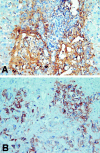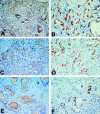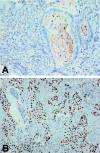Expression of epidermal growth factor receptor, apomucins, matrix metalloproteinases, and p53 in rat and human cholangiocarcinoma: appraisal of an animal model of cholangiocarcinoma
- PMID: 15213623
- PMCID: PMC1356379
- DOI: 10.1097/01.sla.0000129492.95311.f2
Expression of epidermal growth factor receptor, apomucins, matrix metalloproteinases, and p53 in rat and human cholangiocarcinoma: appraisal of an animal model of cholangiocarcinoma
Abstract
Objective: We sought to determine the expression of molecular markers in an animal model of cholangiocarcinoma compared with those in human cholangiocarcinoma.
Summary background data: Cholangiocarcinoma is a rare disease characterized by early intrahepatic and extrahepatic spread, which seriously limits the efficacy of surgery. Establishing an experimental model to study the cholangiocarcinogenesis is desirable.
Methods: Sprague-Dawley rats weighing 300 +/- 50 g were used for the study group. The animals were given 0.3% thioacetamide in tap water continuously. Thirty mass-forming peripheral cholangiocarcinoma patients also were studied. Expression of epidermal growth factor receptor (EGFR), MUC1, MUC2, MUC5AC, MMP-2, MMP-9, and p53 in both human and experimental rat cholangiocarcinoma was examined using immunohistochemistry.
Results: Using thioacetamide 0.3% as a hepatoxin to induce cholangiocarcinoma in rats, microfoci of cancerous cells were detected from 12 weeks, and all experimental rats displayed diffuse mass-forming cholangiocarcinoma after 24 weeks. EGFR was strongly expressed in 14 (47%) of 30 human cholangiocarcinoms and 24 (100%) of 24 rat cholangiocarcinomas, respectively. MUC1 was strongly expressed in all human and rat cholangiocarcinomas, whereas MUC2 and MUC5AC were focally and weakly expressed. MMP-2 and MMP-9 were strongly expressed in 22 (73%) of 30 human cholangiocarcinomas and 24 (100%) of 24 rat cholangiocarcinomas, respectively. p53 overexpression was detected in 9 (30%) of 30 human cholangiocarcinoma and none of the rat cholangiocarcinoma, respectively.
Conclusions: The expression of EGFR, apomucins, MMPs, and p53 in rat cholangiocarcinoma was strongly homologous to human cholangiocarcinoma. Thioacetamide-induced cholangiocarcinoma in rats provides an excellent model for investigating cholangiocarcinogenesis in vivo.
Figures





Similar articles
-
The expression of matrix metalloproteinases in intrahepatic cholangiocarcinoma, hilar (Klatskin tumor), middle and distal extrahepatic cholangiocarcinoma, gallbladder cancer, and ampullary carcinoma: role of matrix metalloproteinases in tumor progression and prognosis.Turk J Gastroenterol. 2009 Mar;20(1):41-7. Turk J Gastroenterol. 2009. PMID: 19330734
-
Cholangiocarcinomas arising in cirrhosis and combined hepatocellular-cholangiocellular carcinomas share apomucin profiles.Am J Clin Pathol. 1998 Mar;109(3):302-8. doi: 10.1093/ajcp/109.3.302. Am J Clin Pathol. 1998. PMID: 9495202
-
Altered mucin gene expression in stone-containing intrahepatic bile ducts and cholangiocarcinomas.Dig Dis Sci. 2001 Oct;46(10):2166-72. doi: 10.1023/a:1011906830301. Dig Dis Sci. 2001. PMID: 11680592
-
Role of ErbB family receptor tyrosine kinases in intrahepatic cholangiocarcinoma.World J Gastroenterol. 2008 Dec 14;14(46):7033-58. doi: 10.3748/wjg.14.7033. World J Gastroenterol. 2008. PMID: 19084911 Free PMC article. Review.
-
Biliary cancer growth factor pathways, cyclo-oxygenase-2 and potential therapeutic strategies.J Gastroenterol Hepatol. 2001 Apr;16(4):363-72. doi: 10.1046/j.1440-1746.2001.02438.x. J Gastroenterol Hepatol. 2001. PMID: 11357901 Review.
Cited by
-
Molecular Markers in the Pathogenesis of Cholangiocarcinoma: Potential for Early Detection and Selection of Appropriate Treatment.Gastroenterology Res. 2009 Jun;2(3):132-140. doi: 10.4021/gr2009.06.1299. Epub 2009 May 20. Gastroenterology Res. 2009. PMID: 27933122 Free PMC article. Review.
-
Liver carcinogenesis: rodent models of hepatocarcinoma and cholangiocarcinoma.Dig Liver Dis. 2013 Jun;45(6):450-9. doi: 10.1016/j.dld.2012.10.008. Epub 2012 Nov 22. Dig Liver Dis. 2013. PMID: 23177172 Free PMC article. Review.
-
HER3 overexpression is a prognostic indicator of extrahepatic cholangiocarcinoma.Virchows Arch. 2012 Nov;461(5):521-30. doi: 10.1007/s00428-012-1321-0. Epub 2012 Oct 2. Virchows Arch. 2012. PMID: 23052372 Free PMC article.
-
Animal PET for thioacetamide-induced rat cholangiocarcinoma: a novel and reliable platform.Mol Imaging Biol. 2008 Jul-Aug;10(4):209-16. doi: 10.1007/s11307-008-0141-8. Epub 2008 May 20. Mol Imaging Biol. 2008. PMID: 18491193
-
The role of the myofibroblast in tumor stroma remodeling.Cell Adh Migr. 2012 May-Jun;6(3):203-19. doi: 10.4161/cam.20377. Epub 2012 May 1. Cell Adh Migr. 2012. PMID: 22568985 Free PMC article. Review.
References
-
- Chen MF, Jan YY, Wang CS, et al. Intrahepatic duct stone associated with cholangiocarcinoma. Am J Gastroenterol. 1989;84:391–395. - PubMed
-
- Chen MF, Jan YY, Wang CS, et al. A reappraisal of cholangiocarcinoma in patients with hepatolithiasis. Cancer. 1993;71:2461–2465. - PubMed
-
- Yeh TS, jan YY, Tseng JH, et al. Malignant perihilar biliary obstruction: magnetic resonance cholangiopancreatographic findings. Am J Gastroenterol. 2000;95:432–440. - PubMed
-
- Jan YY, Yeh TS, Chen MF. Cholangiocarcinoma presenting as pyogenic liver abscess. Is its outcome influenced by concomitant hepatolithiasis? Am J Gastroenterol. 1998;93:253–255. - PubMed
MeSH terms
Substances
LinkOut - more resources
Full Text Sources
Medical
Research Materials
Miscellaneous

